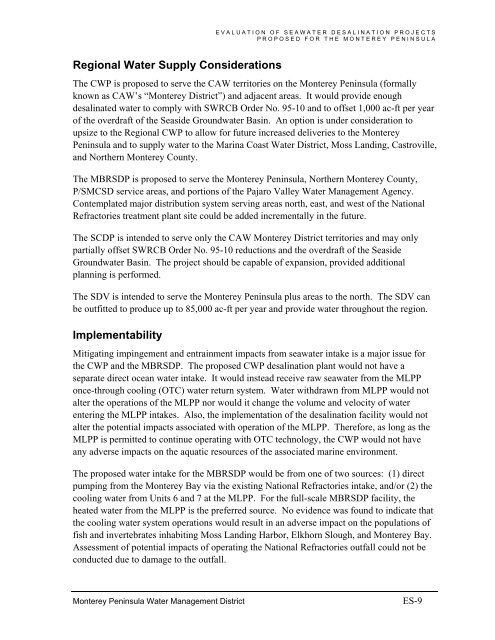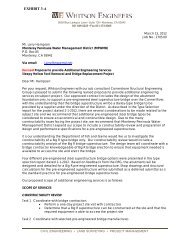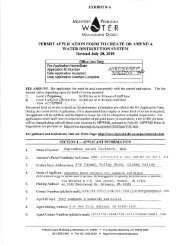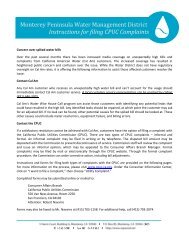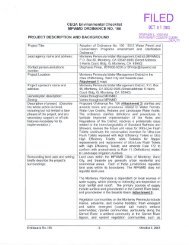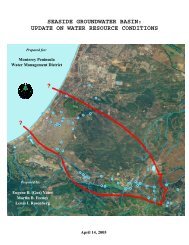FINAL REPORT Evaluation of Seawater Desalination Projects ...
FINAL REPORT Evaluation of Seawater Desalination Projects ...
FINAL REPORT Evaluation of Seawater Desalination Projects ...
Create successful ePaper yourself
Turn your PDF publications into a flip-book with our unique Google optimized e-Paper software.
EVALUATION OF SEAWATER DESALINATION PROJECTS<br />
PROPOSED FOR THE MONTEREY PENINSULA<br />
Regional Water Supply Considerations<br />
The CWP is proposed to serve the CAW territories on the Monterey Peninsula (formally<br />
known as CAW’s “Monterey District”) and adjacent areas. It would provide enough<br />
desalinated water to comply with SWRCB Order No. 95-10 and to <strong>of</strong>fset 1,000 ac-ft per year<br />
<strong>of</strong> the overdraft <strong>of</strong> the Seaside Groundwater Basin. An option is under consideration to<br />
upsize to the Regional CWP to allow for future increased deliveries to the Monterey<br />
Peninsula and to supply water to the Marina Coast Water District, Moss Landing, Castroville,<br />
and Northern Monterey County.<br />
The MBRSDP is proposed to serve the Monterey Peninsula, Northern Monterey County,<br />
P/SMCSD service areas, and portions <strong>of</strong> the Pajaro Valley Water Management Agency.<br />
Contemplated major distribution system serving areas north, east, and west <strong>of</strong> the National<br />
Refractories treatment plant site could be added incrementally in the future.<br />
The SCDP is intended to serve only the CAW Monterey District territories and may only<br />
partially <strong>of</strong>fset SWRCB Order No. 95-10 reductions and the overdraft <strong>of</strong> the Seaside<br />
Groundwater Basin. The project should be capable <strong>of</strong> expansion, provided additional<br />
planning is performed.<br />
The SDV is intended to serve the Monterey Peninsula plus areas to the north. The SDV can<br />
be outfitted to produce up to 85,000 ac-ft per year and provide water throughout the region.<br />
Implementability<br />
Mitigating impingement and entrainment impacts from seawater intake is a major issue for<br />
the CWP and the MBRSDP. The proposed CWP desalination plant would not have a<br />
separate direct ocean water intake. It would instead receive raw seawater from the MLPP<br />
once-through cooling (OTC) water return system. Water withdrawn from MLPP would not<br />
alter the operations <strong>of</strong> the MLPP nor would it change the volume and velocity <strong>of</strong> water<br />
entering the MLPP intakes. Also, the implementation <strong>of</strong> the desalination facility would not<br />
alter the potential impacts associated with operation <strong>of</strong> the MLPP. Therefore, as long as the<br />
MLPP is permitted to continue operating with OTC technology, the CWP would not have<br />
any adverse impacts on the aquatic resources <strong>of</strong> the associated marine environment.<br />
The proposed water intake for the MBRSDP would be from one <strong>of</strong> two sources: (1) direct<br />
pumping from the Monterey Bay via the existing National Refractories intake, and/or (2) the<br />
cooling water from Units 6 and 7 at the MLPP. For the full-scale MBRSDP facility, the<br />
heated water from the MLPP is the preferred source. No evidence was found to indicate that<br />
the cooling water system operations would result in an adverse impact on the populations <strong>of</strong><br />
fish and invertebrates inhabiting Moss Landing Harbor, Elkhorn Slough, and Monterey Bay.<br />
Assessment <strong>of</strong> potential impacts <strong>of</strong> operating the National Refractories outfall could not be<br />
conducted due to damage to the outfall.<br />
Monterey Peninsula Water Management District<br />
ES-9


